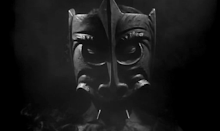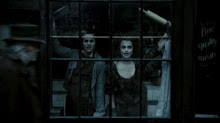So the I was around fifteen, I’d explored world cinema, the American classic style, and even had begun to dip my toe into the wild world of cult movies. I was beginning to feel pretty cocky about my vocabulary. What more was there to see?
There is no more dangerous time for a cinephile then the time when he first begins to fool himself into thinking he knows something. It’s a pattern I’ve seen countless film fans fall into, the happy complacency with a few hundred films to revisit. Only occasionally making room for the odd contemporary film.
It’s death for a student of film. And if you’re extremely lucky you get to see a few films that let you know just how small your palate is.
And that’s why no matter how disparate these film’s might appear, in my mind their intrinsically linked. No two films so violently expanded my horizons. And thanks to them, the day I stop seeking new experiences at the cinema, the day I’m convinced I’ve seen all it has to give, will be the day I’m lying cold in my grave.

Of the two, Aguirre is perhaps the easiest to understand as a shock to the system. I had just fallen under the tutelage of Ebert’s grandfatherly prose, and was drawn to the film by his Great Movie essay. I don’t know what I expected… No that’s a lie, I do know what I expected because the Hollywood version of Aguirre The Wrath Of God is depressingly easy to imagine.
One can picture it now, the scenes of the frightened conquistador’s trembling in the jungle being picked off one by one by an unseen force. A Predator-lite, with plenty of ambient sound, tense low angled shots, and frenzied character actor’s screaming “WHERE ARE YOU!!” into the jungle, a handsome, perhaps gone slightly to seed leading man in the role of the charismatic Aguirre, desperately trying to lead what remains of his conquistador’s out of the jungle, as a budding romance kindles between him and his deceased captain’s wife, and his plucky daughter learns to live in a man’s world. This is before the climatic battle between himself and the Indian tribe in which he gains their grudging respect. Ending up cleansed in his struggle for survival from his nasty imperialist impulses.
You know, some horseshit like that.
What I got was a mixture between holy man’s vision, and delirium induced vision of ants crawling out of one’s skin. A meditive journey into death and madness, filled with unforgettable images, and “ecstatic truth”. To say it was nothing like anything else I’d ever seen before, would be an understatement. As our doomed legion drift’s farther down the river each either reverts to base and cruel animal nature, or into philosophic abstraction. Until the unforgettable ending scene in which Kinski struts around a sinking raft amid a pile of corpses, talking about marrying his (dead) daughter, while he squeezes monkey’s in his fist.
And Oh Kinski, what have we here, bulging eyes, and thick, sensuous, rotten lips drawn into a rictus, remembering you’re supposed to have a hunchback perhaps 40 percent of the time.
But it wasn’t just the madness, it was Herzog, whose style of filmmaking was so different from anything else I’d ever seen that it may have well as been. To say Herzog lacked the concerns about the norms of narrative filmmaking would be an understatement. But his films were so unabashedly narrative.
Cinema wasn’t just a language, it was a language vast enough to contain a foreign one. It was simply put a rush.

But while Aguirre was an attack on the conventions of cinema I held. Almost as much of a threat as a promise. A Personal Journey Through American Movies With Martin Scorsese, on the other hand, presented a perfect example, and articulation of what I considered and consider cinema to be. A quasi mystical passing down of experience through the ages. A retelling of the experiences of common humanity and ideals, occasionally ugly common humanity and ideals, through the ages.
Unlike all other art forms, I would argue that the cinema is primarily not a reach inward, or a reach outward, but a reach forward.
A Personal Journey Through American Movies, proved a warm illustration of this. With Scorsese acting as the ideal tour guide, opening up the history of film as a nourishing buffet. Cementing Scorsese as the ultimate master, the ultimate teacher from whom I would always try to learn.
The filmmakers who this film introduced me to are almost innumerable, but just off the top of my head there’s, Sam Fuller, Raoul Walsh, Vincent Minnelli, Nicholas Ray, Griffith, Von Stroheim, Wild Bill Welleman, William Wyler, Fritz Lang, Anthony Mann, and Robert Aldrich.
That is, if I may be vulgar, that’s a shit ton of movies.
Simply put no single act of cinema going expanded my vocabulary and palate more. No single act of cinema going so made me a better film fan. It was a gentle quantum leap. A mellow but firm reminder that I was only a student. That there was always more to learn,
I can only hope that this will always be so.





































































































3 comments:
'Aguirre' was the second Herzog film I saw (after 'Fitzcarraldo'). I can't even begin to describe the effect it had on me, just minutes into the film, when Herzog holds on a medium shot of a raging torrent of muddy water surging downriver ... and holds ... and holds ... for what seems like an eternity, so long that the fervid intensity of the water becomes hypnotic.
Then he cuts to a close-up and holds the shot for almost as long again!
I was awestruck. Open-mouthed. I didn't know you could hold a shot for that long. Okay, I'd seen a couple of Tarkovsky's films by that time and I knew he could hold a shot for a hell of while, but even Tarkovsky's camera would follow someone, or have people wandering in and out of the frame; there'd be dialogue. Herzog simply pointed his camera at a fucking river. And let it roll. And the effect was visual poetry.
I love Werner Herzog for many many reasons (hell, I named my blog in his honour) but he taught me to love the image for its own beauty, its own meaning and its own power. "Ecstatic truth" - right on, Werner!
Regarding 'A Personal Journey ...' - as Sir Arthur Quiller-Couch's edition of the Oxford Book of English Verse is to an understanding, appreciation and enjoyment of poetry, so Scorsese's documentary to cinema as an art form.
@ Neil: The shot that does that for me, is when the raft of soldiers is caught in the rapids.
It'd be unthinkable for an American film NOT to cut to a close up of panic action on the raft. Instead the film just observes in that medium long shot. So detached that eventually it becomes almost monotonous.
And when they do die, the exact attitude is kept.
Post a Comment